|
feed additive for livestock breeding

CJSC "Respect" presents:
1. Article from "birds and poultry products" № 4 of the 2011 "DRUG APPLICATION Sorbent / ADSORBENT" SAPROSORB "IN FEEDING Broiler"
2. Proceedings of the XVII International Conference WPSA INNOVATION AND DEVELOPMENT In the poultry industry
3.Article from "Zootechniya" № 5, May 2012, "Influence of preparation sorbent / adsorbenta Saprosorb (SaproSORB) on biochemical indices in broiler chickens"
5.Article from "The Russian veterinary journal" № 3 - 2012 Rating sorption capacity of the adsorbent domestic production "Saprosorb" and its effectiveness in growing broiler chickens.
6. Article EFFECTS OF DRUG sorb "SAPROSORB" the lipid content and VITAMINS IN BROILER CHICKEN LIVER AND USE feed nutrient
7. Article APPLICATION sorbed PREPARATION "SAPROSORB" PREVENTION Mycotoxicoses chikens. IV CONGRESS OF THE MATERIALS VETERINARY pharmacologists and Toxicology RUSSIA "CURRENT ISSUES OF VETERINARY TOXICOLOGY, pharmacologists and formations"
8.Article from the newsletter number 19 edition of the weekly operational information from ICC APK Belgorod region, "EFFICIENCY OF FEED ADDITIVES SAPROSORB ORGANIZATIONS BELGOROD REGION"
9.Article from the newsletter number 21 edition of the weekly operational information from ICC APK Belgorod region, "EFFICIENCY OF FEED ADDITIVES SAPROSORB ORGANIZATIONS BELGOROD REGION"
10.Journal article VETERINARY from May 2013: "The dynamics of accumulation and elimination of cesium-137 from the body of mice using sorbent SaproSORB natural origin."
11. "The effectiveness of the feed additive SaproSORB in organizations of Belgorod region" - article from the Belgorod number Agromir March 2013
12.Article from the newsletter number 42 edition of the weekly operational information from ICC APK Belgorod region: "Magical properties of SaproSorb"
13.Article from the newsletter number 43 edition of the weekly operational information from ICC APK Belgorod Region "I.A. Boyko: Innovative feed additive - SaproSorb"
14.Article from the newsletter number 44 edition of the weekly operational information from ICC APK Belgorod region, "V.I. Smolka: SaproSorb - the guarantee of health"
15.Article from the newsletter number 45 edition of the weekly operational information from ICC APK Belgorod region, "P.P. Lyulin - SaproSorb - as a factor in the stability of the farm"
SaproSORB in broiler chickens feeding.

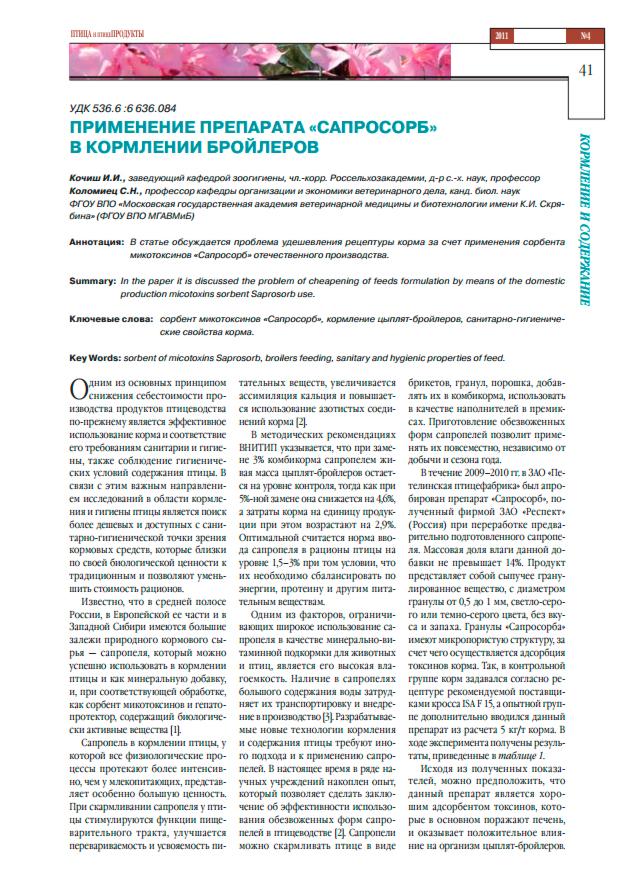
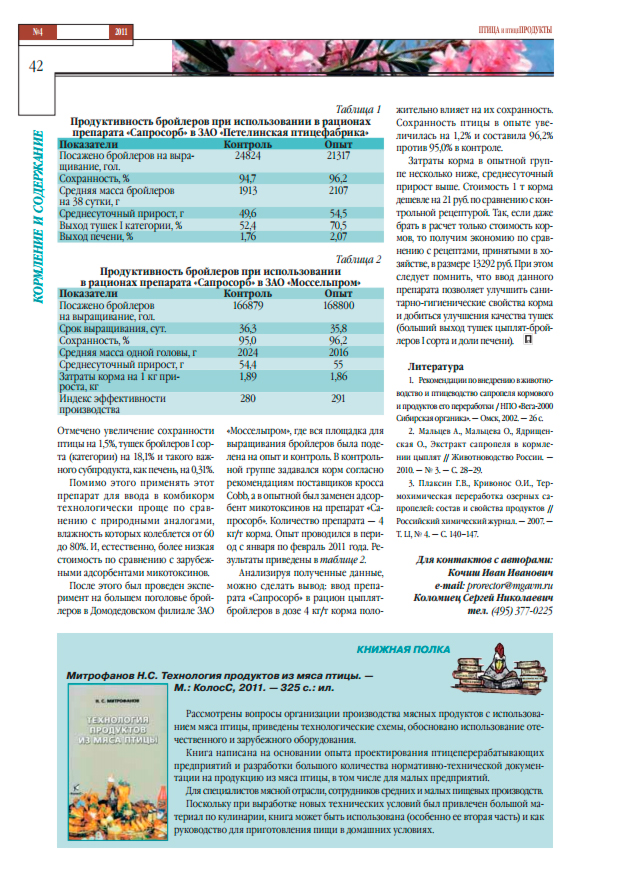
One of the main principles in the cost reduction of poultry products is still the efficient feed usage complying with sanitary and hygienic requirements and also with hygienic conditions of poultry treatment. That is why it is important to find cheaper and moderate healthy feed which has rather the same price and biological value as natural feed.
As is known, Central Russia, European Russia and Western Siberia are rich with sapropel -natural feed, successfully used in poultry feeding and as a feed additive. Being processed properly, it is used as a mycotoxins sorbent and a hepatoprotector containing biologically active substances. [1]
Sapropel is important in poultry breeding, because they have more intensive physiological processes than the mammals. Sapropel stimulates digestive system, improves metabolic process, increases calcium assimilation and feed nitrogenous compounds.
Methodological recommendations of SSI “All-Russian Poultry Research and Technological Institute” show that 3 % feed stuff substitution for sapropel gives control level of broiler liveweight, 5 % substitution lowers it down to 4,6 %. Feed costs increase to 2,9 %.
1,5 – 3 % is the optional level of sapropel introduction into the feed stuff on the stipulation that the feed should be balanced in energy, protein and other nutrients.
High moisture content is one of the factors which limits sapropel to be wide handled as a mineral and vitamin additive to cattle and poultry. It makes difficulties for transportation and its introduction to the producing process.
Development of new feed technologies and poultry breeding demands different way of sapropel usage.
At the present time there is experience accumulated in a number of scientific institutes which makes it possible to conclude dry sapropel is effective in poultry breeding. [2]
Feed sapropel in the form of a block, as a powder, in granulated form, add it to the feed stuff or use as filler in premixes. Dry sapropel can be applied everywhere, irrespective of the year season or production.
During the period from 2009 to 2010 SaproSORB produced by ZAO “Respect” had been testing in ZAO “Petelinskaya Poultry Farm”. Moisture content of the additive is up to 14 %. The product is a light-grey or dark-grey, odor- and tasteless granulated substance with granule diameter from 0,5 to 1mm. Its microcellular granules adsorbate toxins in feed.
The control group was fed according to the recipe recommended by cross ISA F 15 providers, the experimental group had SaproSORB in an amount of 5 kg/ton. Tab. 1 shows us the research results. On its basis we can assume that SaproSORB is good adsorbent of toxins affecting liver and good for broiler chickens.
Tab.1
Broiler chickens productivity while SaproSORB
was used in ZAO “Petelinskaya Poultry Farm”
| Index |
Control |
Experiment |
| Broilers placed on growing, head |
24824 |
21317 |
| Safety, % |
94.7 |
96.2 |
| Average broiler weight on the 38 day, g |
1913 |
2107 |
| Average daily additional weight, g |
49.6 |
54.5 |
| 1 class trunks yield, % |
52.4 |
70.5 |
| Liver yield, % |
1.76 |
2.07 |
Tab.2
Broiler chickens productivity while SaproSORB
was used in ZAO “Mosselprom”
| Index |
Control |
Experiment |
| Broilers placed on growing, head |
166879 |
168800 |
| Breeding period, days |
36.3 |
35.8 |
| Safety, % |
95.0 |
96.2 |
| Average weight of 1 head, g |
2024 |
2016 |
| Average daily additional weight, g |
54.4 |
55 |
| Feed costs per 1 kg of the average weight |
1.89 |
1.86 |
| Production effectiveness index |
280 |
291 |
Poultry safety is 1,5 %, 1 class broiler trunk 1, 8 %, liver 0, 3 %. Besides, it is easily to use SaproSORB than шеф natural analogues containing moisture in an amount from 60 to 80 %. SaproSORB costs cheaper than foreign mycotoxins adsorbents, what is natural.
There was another experiment occurred in ZAO “Mosselprom” where the greater quantity of broiler chickens was divided into the control and the experimental group. The control group was fed according to cross Cobb providers recommendations. In the experimental group SaproSORB replaced a mycotoxins sorbent. The amount of SaproSORB was 4kg/ton of the feed. The experiment had been occurring during the period from Jan to Feb 2011. The results are showed in Tab.2.
The conclusion is that SaproSORB in chicken feed in the amount of 4kg/ton of the feed is good for their safety. The safety increased in the experimental group up to 1,2% and made 96,2 % to 95,0 % in the control group.
Feed costs in the control group is slightly lower and average daily increase is higher. The cost of 1 tonne of the feed is 21 RUB cheaper than the its cost in the control recipe. Thus, only feed economy is 13292 rubles.
SaproSORB should be remembered to improve sanitary and hygienic feed properties and trunks quality (there is bigger yield of 1 class broilers and liver).
List of references:
- Recommendations of the feed sapropel introduction to cattle and poultry breeding and its refined products. / NGO “Vega – 2000” Siberian organic: - Omsk, 2002. – p.26
- Maltsev A., Maltseva O., Yadrischenskaya O., Sapropel extract in chicken breeding // Russian cattle breeding – 2010 - №3-p. 28-29
- Plaksin G.V., Krivonos O.I., Lake sapropels heat treatment: the composition and the properties of the product // Russian chemical magazine – 2007-T. LI. №4-140147
Authors` contacts
Koshich Ivan Ivanovich
e-mail:
Этот e-mail адрес защищен от спам-ботов, для его просмотра у Вас должен быть включен Javascript
Kolomiyez Sergey Nikolayevich
Tel. (495) 377- 0225
The report from XVII International WPSA (World`s Poultry Science Association) Conference

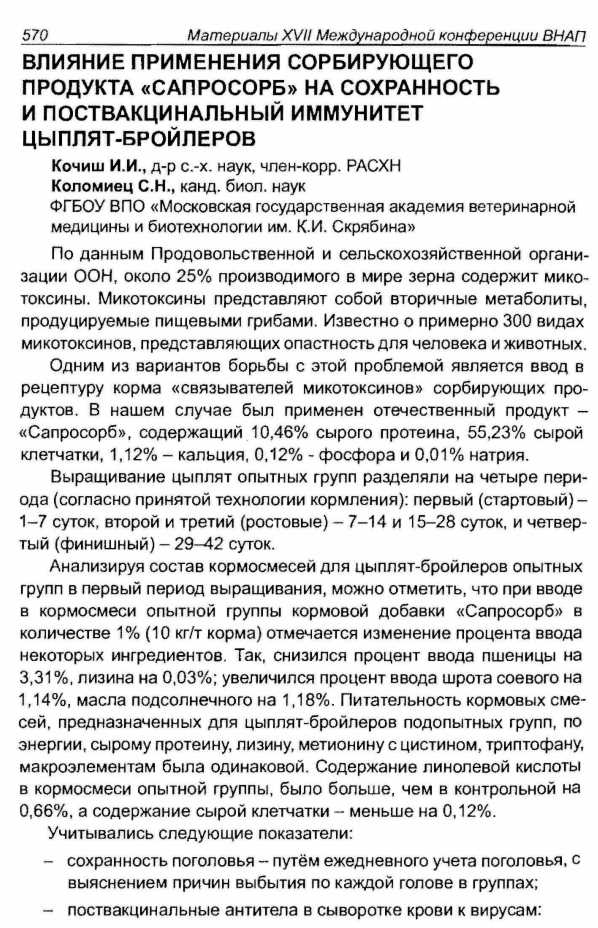
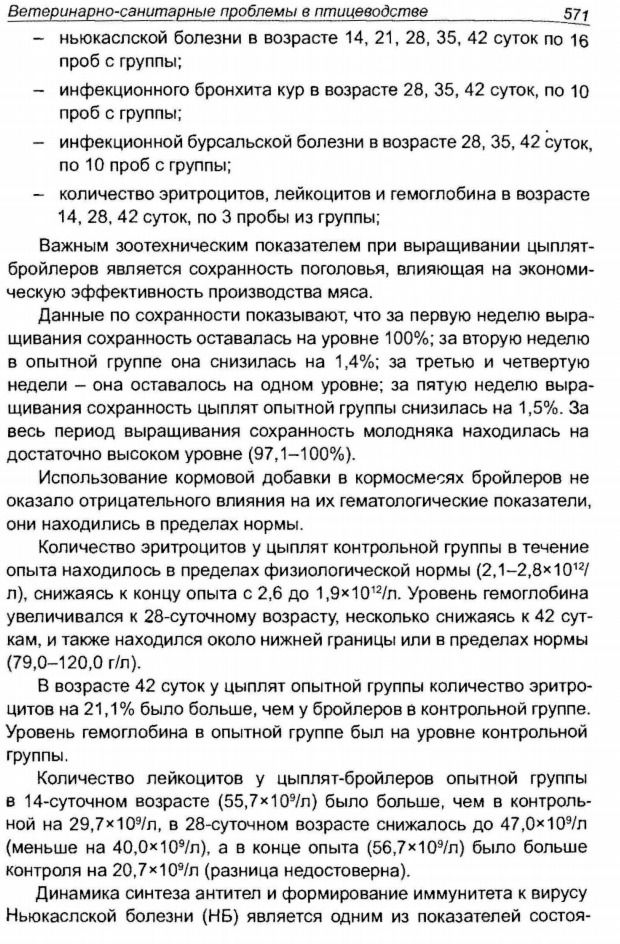
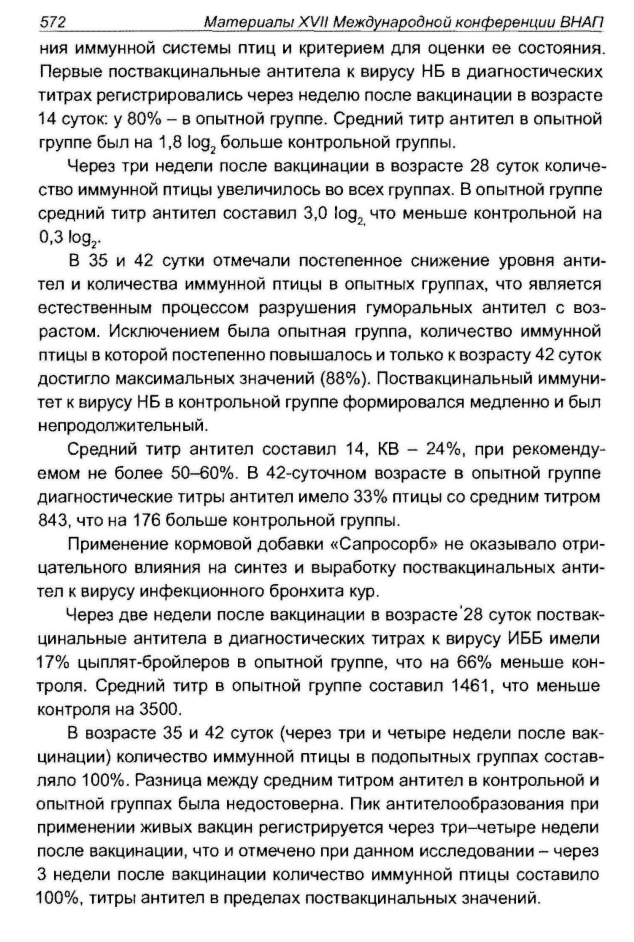
INNOVATIONS AND THEIR DEVELOPMENT IN THE POULTRY INDUSTRY
The influence of SaproSORB sorbing agent on the safety and the post-vaccination immunity of broiler chickens
Koshich I.I., Head of the Zoohygiene Department, the Associate Member of the RAA, DAgrSc, professor
Kolomiyez S.N., the professor of the Organization and Veterinary Economy Department, PhD
FGBOU VPO “Moscow State Academy of Veterinary Medicine and Biotechnology named after K.I. Skryabin” (FGBOU VPO MGAVMiB)
Key words: SaproSORB sorbent of mycotoxins, safety, post-vaccination antibodies, erythrocytes, leukocytes, hemoglobin.
Heading: veterinary and sanitary problems in poultry breeding
As reported by the Food and Agricultural Organization of the UN, 25% of all the corn producing in the world contains mycotoxins. Mycotoxins are secondary matabolites produced by mushrooms. There are around 300 types of mycotoxins dangerous for humans and animals.
One of the way to solve this problem is to add “ mycotoxins binder” of sorbing agents to the feed recipe. In this particular case we used Russian sorbing agent SaproSORB, which contains 10,46 % of raw protein, 55,23 % of raw cellulose, 1,12 % of calcium, 0,12 % of phosphorus, 0,01 % of sodium.
The chickens were bred in four periods (according to the adopted feed technology): the first (starting) 1-7 days, the second and the third (growing)7-14 and 15-18 days and the fourth (finishing) 29-42 days.
Analyzing the composition of the feedmixtures for the broilers in the experimental groups during the first breeding period, it should be noted that there observed a change in the insertion percent of some ingredients by SaproSORB adding into the feedmixtures of the experimental group at the amount of 1 % (10kg/ton of the feed). Thus, wheal insertion percent dropped by 3,31%, lysine by 0,03%, soy extraction cake percent increased to 1,14%, sunflower oil to 1,18%. Feedmixtures nutrition value for the broilers was equal in energy, raw protein, lysine, methionine and cystine, tryptophan and macro elements index. The content of linoleic acid was in the experimental group 0,66% up to the control, raw cellulose content – down to 0,12%.
The following indexes were taken into account:
- Total number safety – daily head accounting
Post-vaccination antibodies in the blood serum to viruses
- Newcastle disease at an age of 14, 21, 28, 35, 42 days, 16 samples from a group
- Chicken infectious bronchitis at an age of 28, 35, 42 days, 10 samples from a group
- Infectious Bursal disease at an age of 28, 35, 42 days, 10 samples from a group
- Erythrocytes, leukocytes, hemoglobin indexes at an age of 14, 28, 42days, 3 samples from a group;
Total number safety is an important index in broiler breeding, it has an influence on economy effectiveness of the production.
Safety data show that there was 100% safety during the first breeding week; the second week lowered the index down to 1,4%; on the third and the fourth weeks it remained stable; the firth week lowered the safety down to 1,5%. The safety was high (97,1 – 100%) during all the breeding period.
The feed additive did not have a bad influence on the hematological indexes, they were within the standard.
Erythrocytes index in the control was also within the standard.
(2,1-2,8*1012/л), it lowered in the end of the experiment to 2,6 до 1,9*1012/л.
Hemoglobin level increased by the age of 28 days, lowered a little to the 42 day, it was also within the standard(79,0-120,0 г/л).
At the age of 42 days the chickens in the experimental group had 21,1% of erythrocytes more than the chickens in the control one. Hemoglobin level was equal.
Leukocytes index in the experimental group at the age of 14 days (55,7*109/л) was higher, than in the control to 29,7*109/л, at the age of 28 days it lowered down to47,0*109/л (40,0*109/л less), and in the end of the experiment (56,7*109/л ) it was higher than in the control group 20,7*109/л (the difference is not true).
The evolution of the antibodies synthesis and immune formation against the Newcastle disease (ND) is one of the chicken condition index and the criteria for chickens` condition. The first post-vaccination antibodies against the ND virus were observed in a week after the vaccination at the age of 14 days: 80% in the experimental group had them. The average titre in the experimental group was 1,8 log2 up to the control one.
Three weeks after the vaccination at the age of 28 days the quantity of the immune broilers increased in both groups. In the experimental group the average antibody titre was 3,0 log2, it is 0,3%.less than in the control.
On the 35 and 42 days the quantity of the antibodies and the immune chickens lowered, what is natural because of the destruction process of humoral antibodies with aging. One of the experimental groups was an exception, the quantity of the immune broilers there increased to the maximum index (88%) only on the 42 day. Post-vaccination immunity against the ND had been forming slowly and lasted not long.
The average antibody titre was 14, KB – 24%, with the recommendation index within 50-60%. At the age of 42 days the diagnostic t% titre in the experimental group had 33% of the chickens with the average titre of 843, what is 176 up to the control group.
SaproSORB did not have a bad influence on the synthesis and the development of the post-vaccination antibodies against the chicken inflectional bronchitis.
Two weeks after the vaccination at the age of 28 days 17% of the broilers in the experimental group had post-vaccination antibodies against IB virus, what is 66% less than in the control group. The average titre in the experimental group was 1461, what is 3500 less than in the control group.
At the age of 35 and 42 days (three weeks after the vaccination) the quantity of the immune chickens in the groups gained 100%. The difference between the average titre in the experimental and the control group was not true. The maximum level of antibodies formation in the process of live vaccination is observed in tree-four weeks after the vaccination, what is noted in this experiment – in three weeks after the vaccination the quantity of the immune broilers was 100%, antibody titres within the post-vaccination index.
The article from “ZOOTECHNIYA” journal, #5, Mai 2012
SaproSORB influence on biochemical indexes of broiler chickens

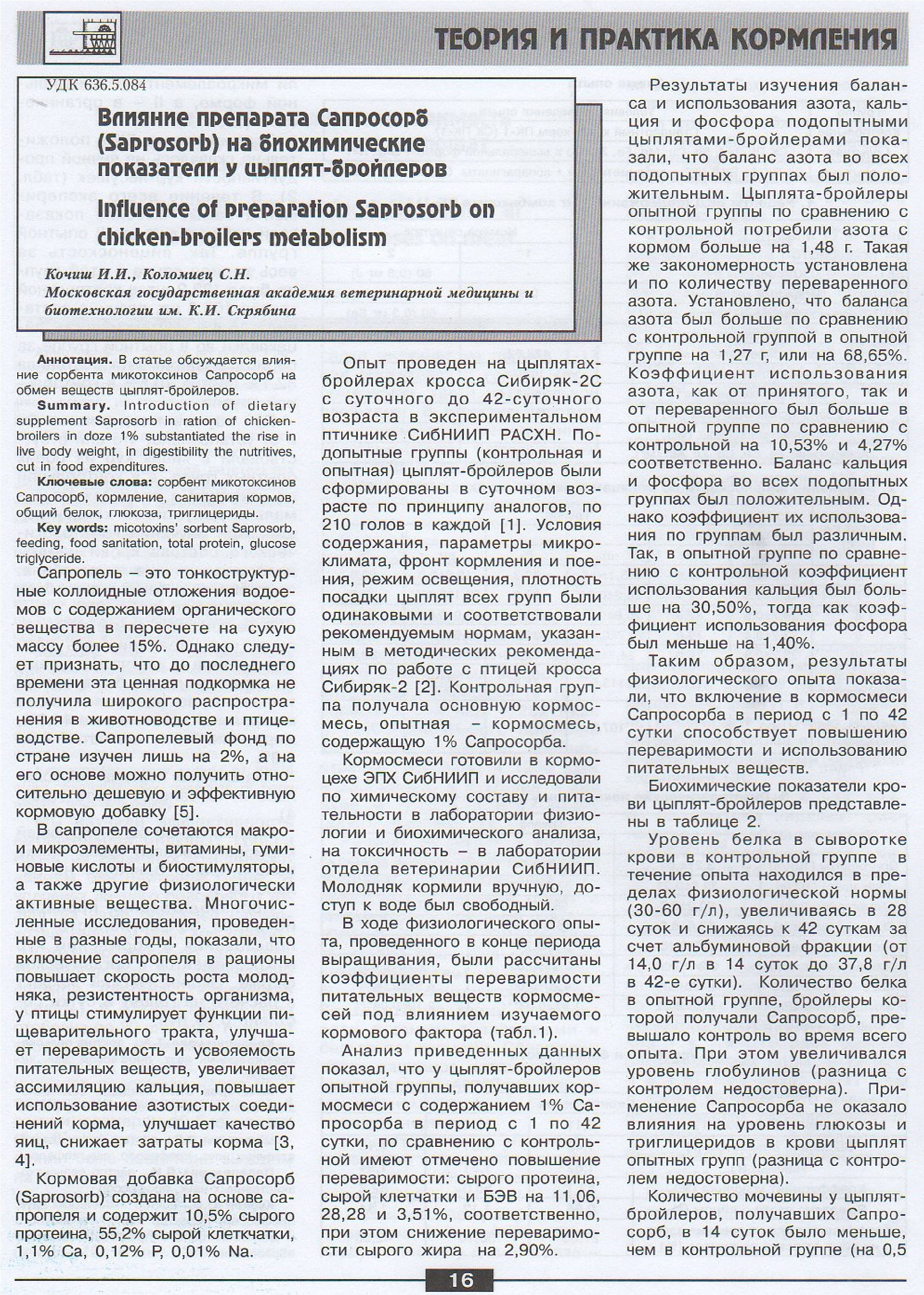
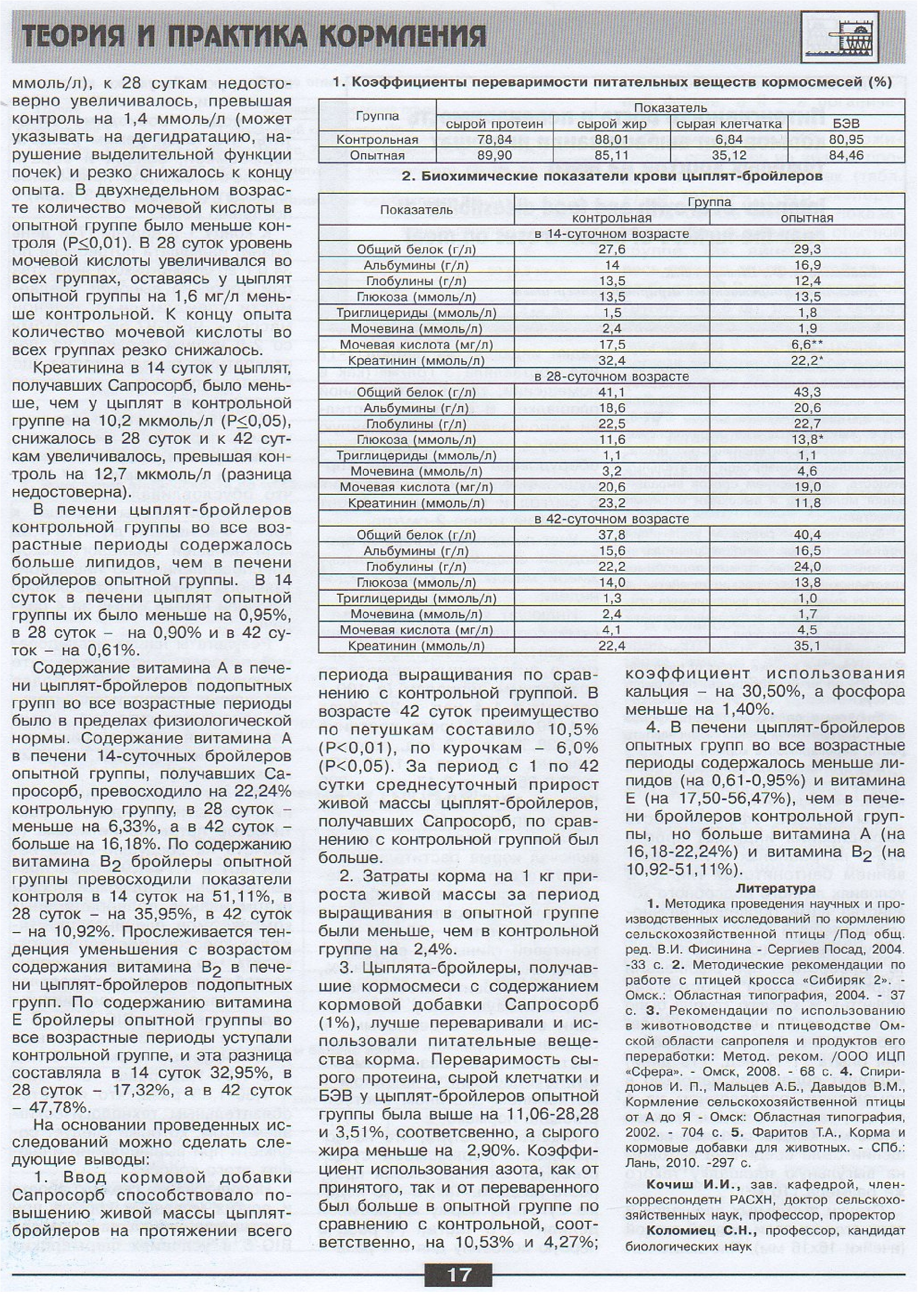
Influence of preparation SaproSORB on
Chicken-broilers metabolism
Koshich I.I., Kolomiyez S.N.
Moscow State Academy of Veterinary Medicine and Biotechnology named after K.I. Skryabin
Key words: SaproSORB sorbent of mycotoxins, feeding, feed sanitary, total protein, glucose triglycerides
Sapropel is fine-structural colloid natural basin sediments with organic substance content in terms of the dry mass around 15%. Though we should admit that this valuable additional fertilizing was not wide distributed in cattle and poultry breeding. Only 2% of the sapropel stock of Russia is examined, and based on it we can get a rather cheap and effective additive. [5]
Sapropel successfully mixes macro and micro elements, vitamins, humic acids, biostimulants and other, physically active substances. Different studies conducted in different years showed that sapropel introduction in feed increases young animals growth, resistance, poultry digestive system stimulated, improves metabolism, increases calcium assimilation, increases usage of the feed nitrogenous compounds, improves egg quality, lowers feed costs [3, 4].
SaproSORB feed additive based on sapropel and contains 10,5% of raw protein, 55,2% of raw cellulose, 1,1% Ca, 0,12% P, 0,01% Na.
The experiment had been conducting on the broilers of the “Sibiryak-2C” cross during the period from 1 to 42 age days in the experimental poultry farm of GNU SibNIIP of the RAA. The experimental groups (the control and the experimental one) were gathered in the first age day, according to the experimental scheme (Tab.1) based on analogue principle, 210 chickens in each group. [1] Treatment conditions, microclimate, feeding, lightning, stocking density were equal and within the methodological recommendations on “Sibiryak-2С” breeding [2].
The feed stuff was cooked by FGUP EPH SibNIIP and examined in the chemical composition and nutritional value by the laboratory of physiology and chemical analysis, in toxicity in the laboratory of the veterinary department of GNU SibNIIP of the RAA. Young animals were fed by hand, water was in free access.
Tab.1
Group feeding quantity period, days
Control basic feed stuff 210 1-42
Experimental 15 SaproSORB feed stuff 210 1-42
Tab.2
Nutrition substances digestion index of broilers
index
Group raw protein,% raw fat ,% raw cellulose,% BEV,%
Control 78,84 88,01 6,84 80,95
Experimental 89,90 85,11 35,12 84,46
The analysis shows that the broilers in the experimental group which had been feeding with 1% SaproSORB feed stuff during 1-42 days, tended to improve digestive index: raw protein, raw cellulose and BEV up to -11,06, -28.28, -3,51, respectively; raw fat digestive index lowered down to 2,90.
Balance and usage of calcium, nitrogen, phosphorus are important, the research results are showed in tab.3
The data show that nitrogen balance was positive in all the experimental groups. The broilers in the experimental group ate 1,48g nitrogen with feed more than the chickens in the control. The same is for digested nitrogen. The nitrogen balance was in the experimental group 1,27 or 68,65% higher than in the control group. Nitrogen usage was 10,53% eaten and 4,27% digested nitrogen up to the control group. Phosphorus and calcium balance was positive in both groups. However, the index and the usage were different. Calcium usage in the experimental group was 30,50% up to the control group, phosphorus usage was instead of it 1,40% down to the control group.
Tab.3
Nitrogen, calcium and phosphorus balance
Index control experiment
Nitrogen
Eaten mixed with feed, g 3.88 5.36
Identified in the feces, g 0.82 0.54
Digested, g 3.06 4.82
Identified in the feces, g 2.03 2.24
Balance 1.85 3.12
Usage index, %
Eaten 47.68 58.21
Digested 60.46 64.73
Calcium
Eaten mixed with feed, g 1.44 1.94
Identified in the feces, g 1.07 0.85
Balance 0.37 1.09
Usage index, %
Eaten 25.69 56.19
Phosphorus
Eaten mixed with feed, g 0.95 1.13
Identified in the feces, g 0.55 0.67
Balance 0.40 0.46
Usage index, %
Eaten 42.11 40.71
SaproSORB used at the age of 1-42 days improves digestive system and nutritional substances usage.
Tab.4
Blood biochemical index of the broiler chickens
Index control experiment
At the age of 14 days
Total protein, g/l 27.6 29.3
Albumin, g/l 14 16.9
Globulin, g/l 13.5 12.4
Glucose, mmol/l 13.5 13.5
Triglycerides, mmol/l 1.5 1.8
Urea, mmol/l 2.4 1.9
Uric acid, mg/l 17.5 6.6**
Creatinine, mkmol/l 32.4 22.2
At the age of 28 days
Total protein, g/l 41.1 43.3
Albumin, g/l 18.6 20.6
Globulin, g/l 22.5 22.7
Glucose, mmol/l 11.6 13.8*
Triglycerides, mmol/l 1.1 1.1
Urea, mmol/l 3.2 4.6
Uric acid, mg/l 20.6 19.0
Creatinine, mkmol/l 23.2 11.8
At the age of 42 days
Total protein, g/l 37.8 40.4
Albumin, g/l 15.5 16.5
Globulin, g/l 22.2 24.0
Glucose, mmol/l 14.0 13.8
Triglycerides, mmol/l 1.3 1.0
Urea, mmol/l 2.4 1.7
Uric acid, mg/l 4.1 4.5
Creatinine, mkmol/l 22.4 35.1
Protein level in the experimental group was within the physiological standard (30-60 g/l), it increased on the 28 day and lowered by the 42 day due to albumin fractions (from 0,14 g/l on the 14 day to 37 g/l on the 42 day).
Total protein in the experimental group eating SaproSORB exceeded the same level in the control group. And globulin level increased (the difference between the experimental and the control group is not true).
SaproSORB did not have an influence on glucose and triglyceride level in the chickens` blood (the difference between the experimental and the control group is not true).
Urea index was in the experimental group 0,5 mmol/l lower than in the control one on the 14 day, it increased by the 28 day (the difference between the experimental and the control group is not true) exceeding the index in the control group up to 1,4 mmol/l (it might be dehydration, violations of renal excretory function).
At the age of 14 days uric acid level was in the experimental group lower than in the control one ((Р < 0,01 )
On the 28 day uric level increased in all the groups, in the control group this index remained 1,6 mg/l lower than in the control. By the end of the experiment the level tended to lower rapidly in all the groups.
Creatinine level in the group of chickens fed with SaproSORB was on the 14 day 10 mkmmol/l (Р < 0,05) lower than in the control group, lowering by the 28 day and increasing by the 42 day exceeding the control group up to 12,7 mkmmol/l (the difference between the experimental and the control group is not true).
Lipid and vitamin level in the liver was tested on the 14, 28, 42 day (tab.5)
The liver in the control group contained more lipids than the liver in the experimental one. Thus, lipid content in the broilers` liver in the experimental group was at the age of 14 days 0,95%, at the age of 28 days 0,90% and at the age of 42 days 0,16% lower than the level in the control group.
Tab.5
Lipid and vitamin content in the broilers` liver
Group index
Lipids, % vitamin A, mg/l vitamin B2, mg/l vitamin E, mg/l
at the age of 14 days
Control 3.84 28.68 9.04 59.73
Experimental 2.89 35.06 13.66 40.05
at the age of 28 days
Control 4.20 79.94 9.29 39.25
Experimental 3.30 74.88 12.63 32.45
at the age of 42 days
Control 3.72 137.30 8.88 35.31
Experimental 3.11 159.52 9.85 18.44
Vitamin A content in the broilers` liver in the experimental groups was within the physiological standard. The experimental group fed with SaproSORB exceeded at the age of 14 days the control one up to 22,24%, at the age of 28 days the leмуд was 6,33% lower, at the age of 42 days the level was 16,18% higher. Vitamin B2 content in the liver in the experimental group was 51,11% up to the control at the age of 14 days, at the age of 28 days up to 35,95%, at the age of 42 days – up to 10, 92%. Vitamin B2 content tended to lower with aging. The experimental group fed with SaproSORB contained vitamin У in the liver less than the chickens in the control group, the difference was 35,95% at the age of 14 days, 17,32% at the age of 28 days, 47,78% at the age of 42 days.
Basing on the experiment we can conclude:
- SaproSORB increased chickens` liveweight in the experimental group, it exceeded the control one in cocks up to 10,5% (P<0,01) at the age of 14 days, in hens up to 6,0%(P<0,05). Average daily additional liveweight was in the period from 1 to 42 days in the experimental group fed with SaproSORB higher than in the control one.
- Feed costs per 1kg additional liveweight in the experimental group fed with SaproSORB was 2,4% less than in the control one.
- The broilers fed with the feed mixed with SaproSORB (1%) digested and used the nutritional substances better. Raw protein, raw cellulose and BEV digest was better – up to 11,06-28,28, and 3,51%, respectively; raw fat digest level was 2,90% lower than in the control group. Nitrogen usage index was 10,53% eaten and 4,27% digested higher than in the control group. Calcium usage index was 30,50% higher and phosphorus 1,40% lower than in the control.
- Lipid and vitamin E content were ( 0,61-0,95%) and (17,50-56,47%) lower than in the control group, respectively. Vitamin A and Vitamin B2 content was higher up to 16,18-22,24% and 10,92-51,11%, respectively.
Federal Budgetary Institution of Higher Education
Moscow State Academy of Veterinary Medicine and Biotechnology named after K.I. Skryabin
Institute for Advanced Studies and Veterinary and Cattle Breeding workers Retraining
Report on the students and the Academy workers participation on the special International
exhibition “Agrofarm – 2012”

The third exposition was made within the partnership with the steering committee of the International exhibition “Agrofarm – 2012” in the infocenter of “Prevention mycotoxins in poultry and cattle feeding”. SaproSORB was presented on the stands of the Academy. SaproSORB contains functions of the effective adsorbent of broad spectrum mycotoxins, enriching feed with micro and macro elements, mineral substances, produced according to the contract made between the Academy and ZAO “Respect”.
The exposition was presented by Kolomiyez Sergey Nikolayevich, Assistant Provost for Academic Affairs, the professor of the Organization and Veterinary Economy Department, PH.D.

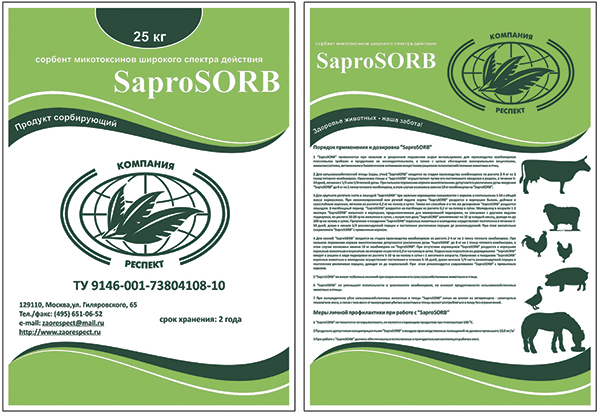
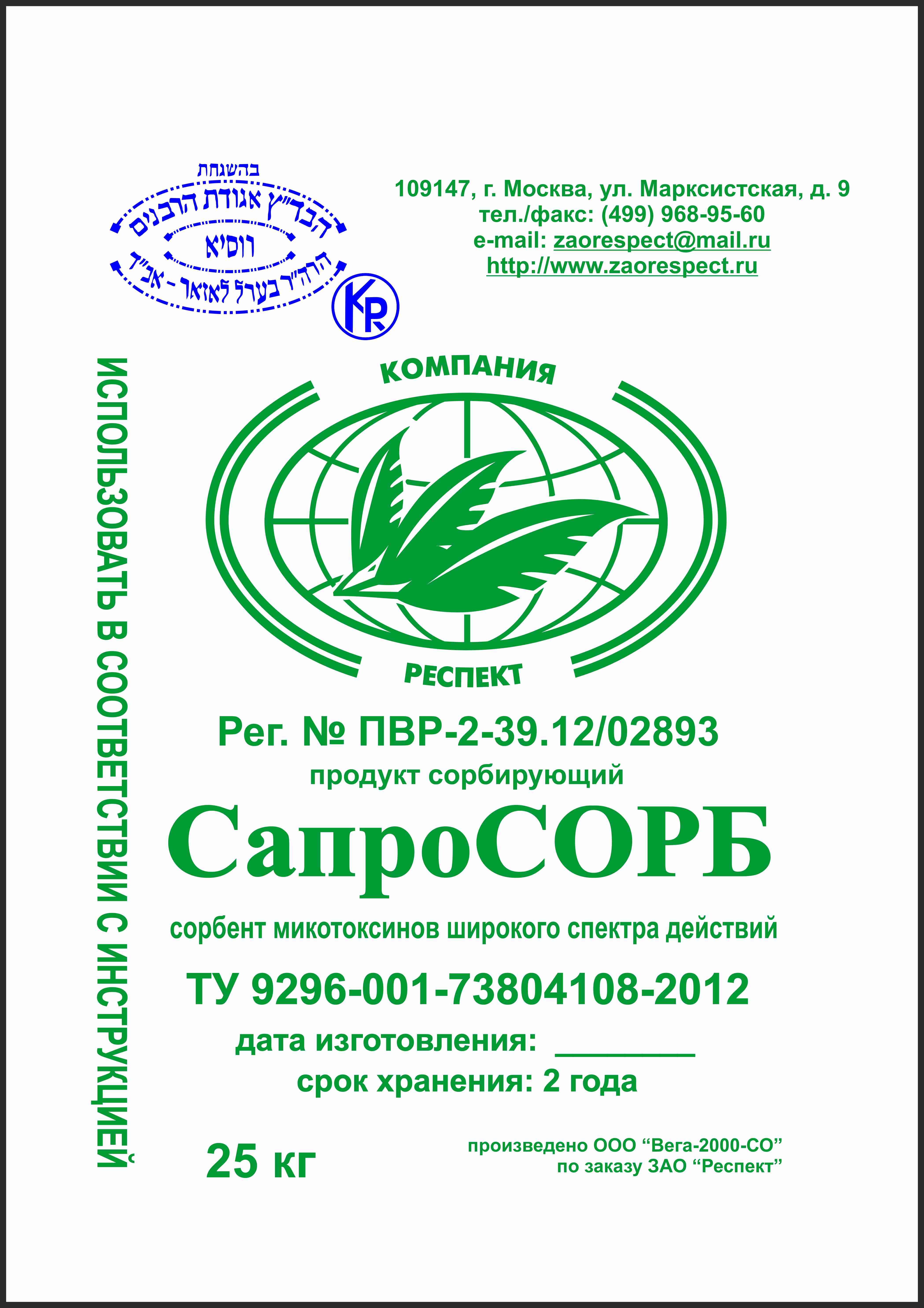 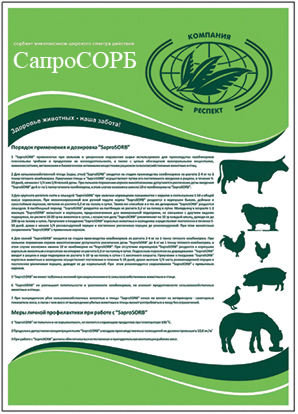
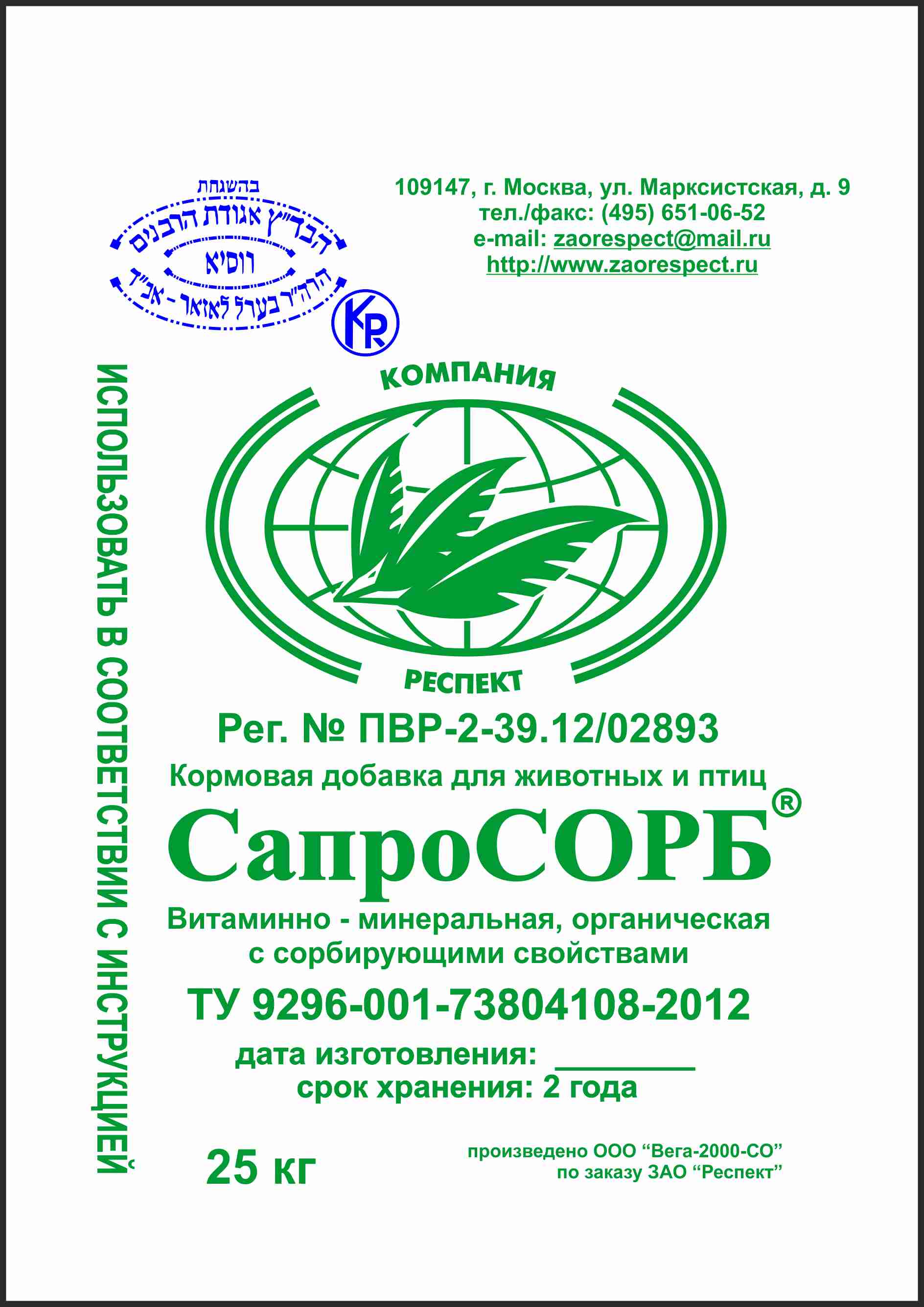 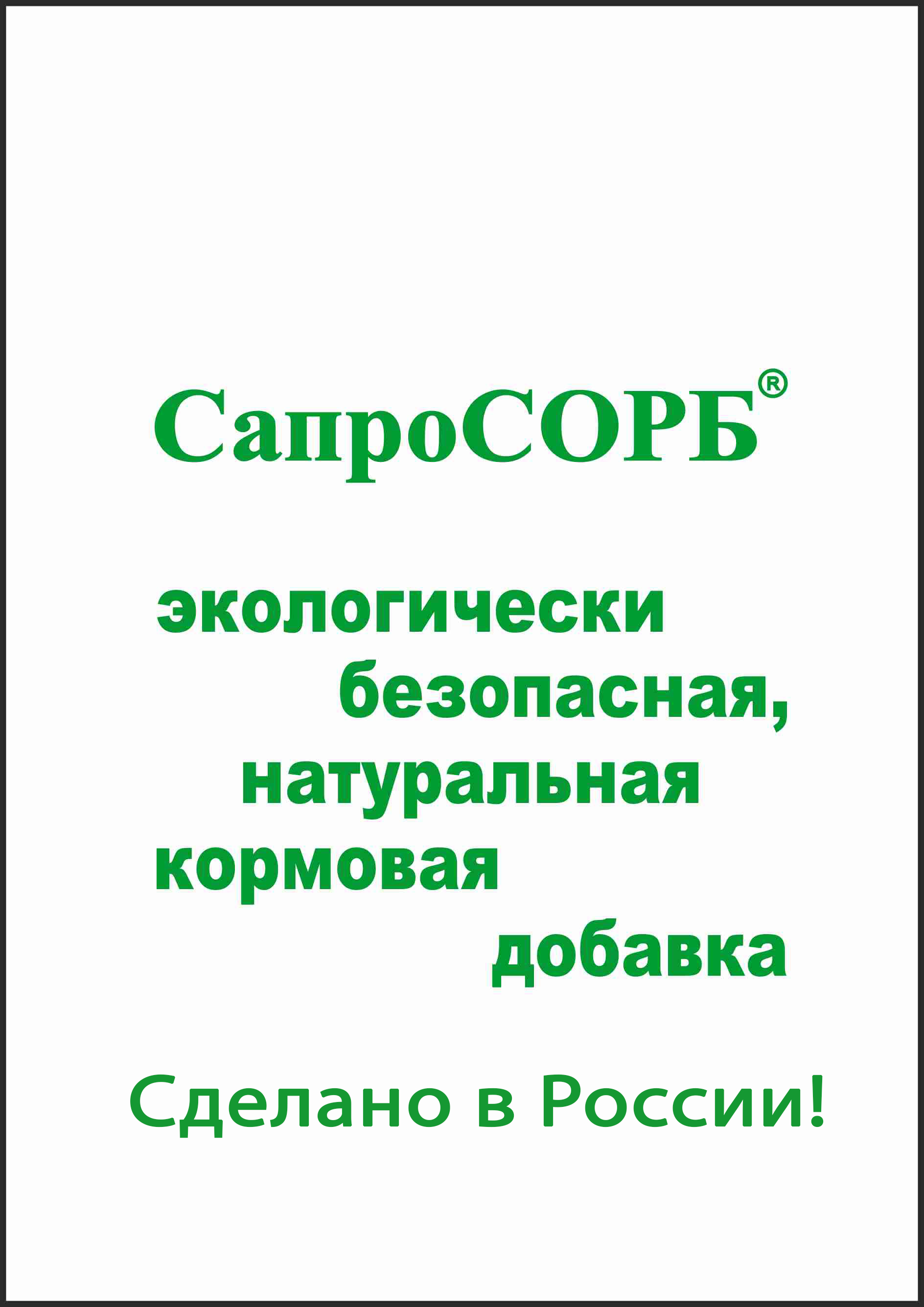
Rating sorption capacity of the adsorbent domestic production and its effectiveness in growing broiler chickens.

I.I. Kochish, Doctor of Agricultural Sciences, S.N. Kolomiets, Ph.D. VPO "Moscow State Academy of Veterinary Medicine and Biotechnology named after KI Scriabin "
Keywords: aflatoxin, zearalenone, ochratoxin, sorbent mycotoxins, safety, fumonisin, broilers
Abbreviations: net efficiency
introduction
Scientific development of new and more effective ways to prevent various diseases of poultry and livestock improvement is an important task of science and practice. No need to describe the enormous harm caused by mycotoxins, which are producers of mushrooms. Suffering from the effects of mycotoxins and the person receiving dangerous doses of these compounds through food.
One of the ways to solve the problem - the use of mycotoxin adsorbents based on sapropel. A number of studies found that the products of this group are not toxic to animals, are not teratogenic, mutagenic and Organotropona danger, are not chemical stressors. With the introduction of these compounds in the diet because of their high adsorption, ion exchange and catalytic properties in the body decreases the level of toxic substances, which positively affects the physiological state and metabolism [2].
As the study drug was taken medication «SaproSORB» ( Saprosorb ) - sorbent mycotoxins broad spectrum . Numerous studies over the years have shown that the inclusion of the sorbent in the animal diet increases the resistance of the organism , the rate of growth of young , the bird stimulates the function of the digestive tract , improves digestibility and nutrient availability , increases assimilation of calcium increases the utilization of nitrogen compounds feed improves the quality of eggs, reduces the cost of feed [4]. But all of these positive properties of this product do not disclose the extent to which SaproSORB binds mycotoxins .
Objective of research
Determine the sorption capacity of the drug «SaproSORB» in studies in vitro. Rate in vivo efficacy as an adsorbent of mycotoxins.
Material and methods
Sorption capacity of the drug was assessed on such criteria as the ICAP [3]. ICAP adsorbent determined from the difference between adsorption and desorption, and expressed as a percentage . ICAP higher , the adsorption efficiency , ie, the greater the associated and correspondingly deactivated mycotoxin . Sorption mycotoxins quantified at different pH, acidity of the medium simulating change in the digestive tract of animals. Magnitude of adsorption and desorption ( mg / kg ) was measured by an approved method ( GOST R 52471-2005 ) . In FGBI " Leningrad Interregional Veterinary Laboratory " study medication was pre-mixed with the model food at an optimal concentration recommended by the manufacturer , and then another with each of miotoksinov alternately . Were taken following mycotoxins : aflatoxin , zearalenone , ochratoxin and fumonisin . To assess the effectiveness of preventive properties of the drug was to hold a production experiment on Broiler cross ISA F- 15 JSC " Petelinskaya ptitsefabrika" Moscow region.
Results and Discussion
Based on the data shown in Table 1, it can be noted that the sorbent «SaproSORB» possesses significant sorption properties in relation to the four mycotoxins ICAP its very high. By aflatoxin, according to the literature [5], the best indicator of ICAP was 53%, in our research value of the index reached 95.5%.
As you know, aflatoxin - a metabolite of fungi Aspergillus, is carcinogenic, nephrotoxic, hepatotoxic, neurotoxic effects, and inhibits protein synthesis. According to mycotoxin poisoning consequence may be a reduction of live weight of broiler chickens, keeping livestock, as well as reduced output percent of products (eg, liver), poultry slaughter.
During the production of the experiment results shown in Table 2. Performance of the experimental group were significantly better. Preservation increased by 1.5%, which is very important when one considers that this indicator in the control is at a high level - 94.7%. Average daily weight gain in the test group was 54.5 g, which is higher by 3.9 g, compared to the control. Percent yield of the liver in the experimental group by 17.6% higher in comparison with that in the control group.
- Sorption capacity «SaproSORB»
| title mycotoxin |
The initial concentration of mycotoxins in feed mcg / kg |
Sorption activity, mcg / kg
|
Desorption activity mcg / kg |
ICAP% |
| aflatoxin |
0,066 |
0,064 |
0,001 |
95,5 |
| zearalenone |
0,761 |
0,761 |
0,000 |
100 |
| ochratoxin |
0,08 |
0,070 |
0,001 |
86,3 |
| fumonisin |
1,89 |
1,65 |
0,11 |
81,5 |
- Production figures when used in diets drug "SaproSORB"
| data |
control |
experiment |
| Planted broiler growing, head |
24824 |
21317 |
| The average live weight of broilers at 38 th day, g |
1913 |
2107 |
| Average daily gain, g |
49,6 |
54,5 |
| Preservation,% |
94,7 |
96,2 |
| I yield carcasses category,% |
52,4 |
70,5 |
| Yield liver, % |
1,76 |
2,07 |
findings
By analyzing the above data we can conclude that the preparation is effective SaproSORB mycotoxin adsorbent not only in vitro. In the experiment, in a production environment, he acted as a means of prevention of liver disease as a consequence the higher safety of livestock and more intense average live weight gain of broilers.
TOM 212
Published since 1883
N.E. BAUMANA
MEDICINE
VETERINARY
ACADEMY
STATE
KAZAN
the Scientific Notes of
INFLUENCE OF PREPARATION "SAPROSORB»
The lipid content and VITAMINS IN BROILER CHICKEN LIVER AND USE feed nutrients
Kolomiets S.N., N.M. Vasilevsky, Mihaliov P.V., A.V. Obrazumova
Key words: sorbent mycotoxins, breastfeeding, sanitation feed.
In sapropel combines macro-and micronutrients , vitamins , humic acid and bio-stimulants and other physiologically active substances . Numerous studies over the years have shown that the inclusion of sapropel in diets increases the rate of growth of young , resistance of the organism in poultry stimulates the function of the digestive tract , improves digestibility and nutrient availability , increases assimilation of calcium increases the utilization of nitrogen compounds feed, improves the quality of eggs reduces the cost of feed [3, 4].
Sapropel - is fine- sediment ponds with colloidal organic matter content in the dry weight of more than 15% . However, we must admit that until recently this valuable fertilizing is not widespread in the livestock and poultry . Sapropel fund in the country studied by only 2 % , and therefore you can get a relatively cheap and effective feed additive [5].
Material and Methods.
Feed additive "Saprosorb" is based on sapropel and contains 10.5% crude protein, 55.2% crude fiber, 1,1% Ca, 0,12% P, 0,01% Na.
Experiment was conducted on broiler chickens cross " Siberian -2C " from day to 42 - day-old poultry house in the experimental GNU SibNIIP RAAS . The experimental group of broilers ( control and test ) are formed at day-old , according to the scheme of the experiment ( Table 1) by analogy to 210 animals each . [1] Conditions of detention , climate parameters , the front feeding and watering , lighting mode , the density of chicks of all groups were similar and consistent with the recommended standards set forth in the methodological recommendations for dealing with bird cross " Siberian -2 " [2] .
Feed mixtures were prepared in preparation center FSUE EPH SibNIIP and studied the chemical composition and nutritional value in the laboratory of physiology and biochemistry, toxicity - in the laboratory of veterinary GNU SibNIIP RAAS. Feeding of young carried out manually, access to water - free.
1. The experimental setup
|
group
|
Features feeding
|
number of heads
|
Period cottages, days.
|
|
control
|
Summary foodmixture
|
210
|
1-42
|
|
eperimental
|
Foodmixture Contains 1% "Saprosorb"
|
210
|
1-42
|
During physiological experiment conducted at the end of the growing period were calculated digestibility coefficients of nutrients under the influence of the studied rations of feed factor (Table 2).
2. Digestibility coefficients of nutrients formula feed broiler chickens experimental groups
|
group
|
index
|
|
protein
crude, %
|
crude fat, %
|
crude fiber, %
|
NFE, %
|
|
control
|
78,84
|
88,01
|
6,84
|
80,95
|
|
experimental
|
89,90
|
85,11
|
35,12
|
84,46
|
Results. Analysis of the data shows that broiler chickens experimental group treated with kormosmesi soderzhaniem1% "Saprosorba" during the 1-42 day compared with controls have a common tendency to increase digestibility by: crude protein, crude fiber and NFE - 11.06 - 28.28 and -3.51%, respectively, while decreased in digestibility of crude fat - 2.90% compared with the control group.
Balance study and use of nitrogen, calcium, phosphorus in the body bird attach great importance on research. Results of the study and use of the balance of nitrogen, calcium and phosphorus guinea broilers are presented in Table 3.
From the results of research shows that nitrogen balance in all experimental groups was positive. Broilers experimental group compared with the control group consumed more feed nitrogen 1.48 g The same pattern is set by the number of digested nitrogen. It has been established that the balance of nitrogen higher than the control group, in the experimental group at 1.27 g or 68.65 %. Utilization of nitrogen as adopted and from digested was greater in the experimental group compared with the control by 10.53% and 4.27% respectively. Balance of calcium and phosphorus in all experimental groups is positive, but their rate of use by different groups . Thus, in the experimental group compared to the control , the calcium utilization higher by 30.5 %, whereas the utilization of phosphorus is less than the figure of 1.4 %.
Thus, the results of physiological experiments show that the inclusion of the feed additive in feed mixtures "Saprosorb" during the 1-42 day increases the digestibility and utilization of nutrients.
3. Nitrogen balance, calcium and phosphorus
|
index
|
group
|
|
control
|
experimental
|
|
nitrogenium
|
|
Taken with food, g
|
3,88
|
5,36
|
|
Allocated in feces, g
|
0,82
|
0,54
|
|
Overcooked, the
|
3,06
|
4,82
|
|
Allocated in the litter, g
|
2,03
|
2,24
|
|
balance
|
1,85
|
3,12
|
|
utilization factor, %
|
|
received from
|
47,68
|
58,21
|
|
from overcooked
|
60,46
|
64,73
|
|
calcium
|
|
Taken with food, g
|
1,44
|
1,94
|
|
Allocated in the litter, g
|
1,07
|
0,85
|
|
balance
|
0,37
|
1,09
|
|
utilization factor, %
|
|
received from
|
25,69
|
56,19
|
|
phosphorus
|
|
Taken with food, g
|
0,95
|
1,13
|
|
Allocated in the litter, g
|
0,55
|
0,67
|
|
balance
|
0,40
|
0,46
|
|
utilization factor, %
|
|
received from
|
42,11
|
40,71
|
Содержание липидов и витаминов в печени цыплят-бройлеров подопытных групп определяли в 14-, 28- и 42-суточном возрасте (табл. 4).
4. The lipid content and vitamins in the liver of broiler chickens experimental groups
|
group
|
index
|
|
Липиды, %
|
Vitamin А, mcg/g
|
Vitamin В2, mcg/g
|
Vitamin Е, mcg/g
|
|
in 14-day-old
|
|
control
|
3,84
|
28,68
|
9,04
|
59,73
|
|
experimental
|
2,89
|
35,06
|
13,66
|
40,05
|
|
in 28-day-old
|
|
control
|
4,20
|
79,94
|
9,29
|
39,25
|
|
experimental
|
3,30
|
74,88
|
12,63
|
32,45
|
|
in 42-day-old
|
|
control
|
3,72
|
137,30
|
8,88
|
35,31
|
|
experimental
|
3,11
|
159,52
|
9,85
|
18,44
|
In the liver of broiler chickens in the control group in all age periods contained more lipids than in the liver of broilers experimental group. Thus, the content of lipids in the liver of experimental groups of chickens in a 14-day age is less than 0.95% in 28 days - 0.90% in 42-day - 0.61%.
The content of vitamin A in the liver of broiler chickens experimental groups in all age periods were within the physiological range . The content of vitamin A in the liver of 14 day old broilers experimental group receiving Saprosorb , superior - 22.24 % on a control group of 28 - day - less than 6.33 %, and 42 - day old - more at 16.18 % . The content of vitamin B2 in the liver of broilers experimental group outperformed the control in the 14- day-old - at 51.11 % in the 28 - day - at 35.95 % in 42 - day-old - at 10.92 %. Decreasing trend with age of vitamin B2 in the liver of broiler chickens experimental groups . On the content of vitamin E in the liver of broilers from the experimental group received a feed additive " Saprosorb " in all age periods yielded the control group and this difference was in the 14- day-old 32.95 % in 28 days - 17.32 %, and 42 - day - 47.78 %.
Conclusions . 1. Introduction of the feed additive " Saprosorb " contributed to increasing live weight of broiler chickens during the growing period compared with the control group , and 42 - day-old cockerels amounted to 10,5% (P <0,01), and for hens 6,0% (P <0,05). During the period 1-42 day average daily performance of live weight gain of broiler chickens fed " Saprosorb " higher compared with the control group . 2 . Feed costs per 1 kg of live weight gain during the period of cultivation in the experimental group receiving " Saprosorb " during the 1-42 day lower than in the control group by 2.4%. 3 . Chicken Broilers receiving feed mixtures with the content of the feed additive " Saprosorb " (1%) , it is better digested and used nutrients feed . Digestibility of crude protein , crude fiber and NFE broilers experimental group was more - 11,06-28,28 and 3.51 % , respectively, but less than the digestibility of crude fat ( 2.90 %) compared with the control group . Utilization of nitrogen as the accepted and digested by was more in the experimental group compared with the control , respectively - by 10.53% and 4.27% ; utilization of calcium - at 30.50 %, and phosphorus he was less than 1.40% . 4 . The liver in broiler chickens experimental groups receiving " Saprosorb " in all age periods contained less lipids ( at 0,61-0,95 %) and vitamin E ( at 17,50-56,47 % ) than in liver broiler control group , but the vitamin A (in % 16,18-22,24 ) and vitamin B2 ( at 10,92-51,11 %).
REFERENCES : 1. Methodology of the scientific and industrial research on feeding poultry / Under total . Ed. VI Fisinin - Sergiev Posad, 2004 . -33 S. 2 . Guidelines for working with bird cross "Siberian 2" . - Omsk . : Regional Printing House , 2004 . - 37 . 3 . Recommendations for the use in livestock and poultry Omsk region sapropel and its products : Method. recombination . / PPI LLC "Sphere" . - Omsk, 2008 . - 68 . 4 . Spiridonov IP, Maltsev AB Davydov, VM, feeding of poultry from A to Z - Omsk Regional Printing House , 2002 . - 704 . 5 . Faritov TA Feeds and feed additives for animals . - St. Petersburg. : Lan , 2010. -297 P.
INFLUENCE OF THE PREPARATION «САПРОСОРБ» (SAPROSORB)
THE CONTENT OF LIPIDS AND VITAMINS IN THE LIVER OF CHICKEN-BROILERS AND USE OF NUTRIENTS FEED
Kolomiets S.N., Vasilevsky N.M., Mikhalev P.V., Obrazumova A.V.
Summary
The article discusses the impact of the sorbent mycotoxins SaproSORB the biochemical indices of metabolism, the coefficients of the digestibility of nutrients.
Kazan 2012
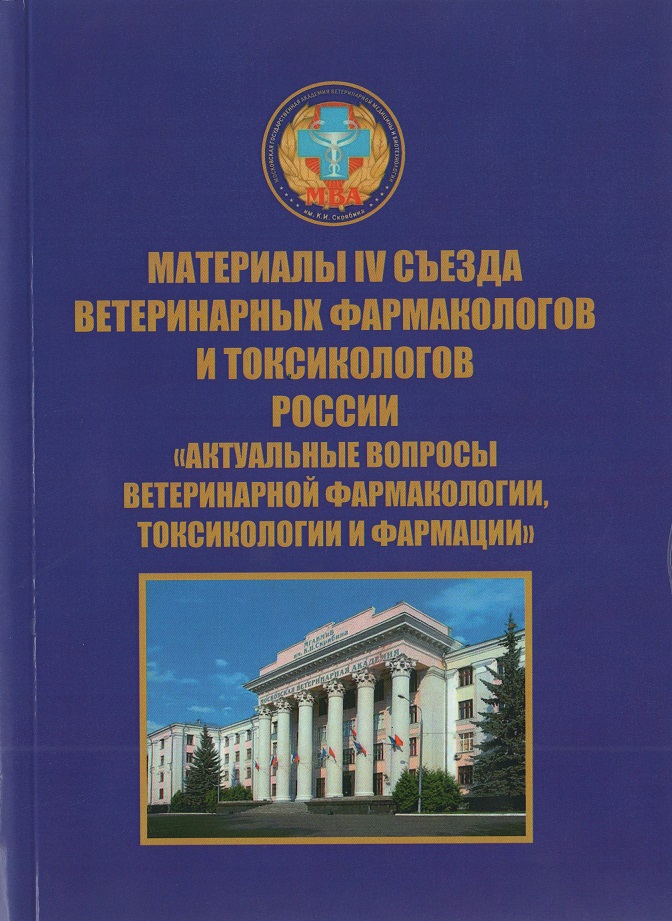
Saprosorb sorbent application to prevent mycotoxin chickens. Kochish I.I., S.N. Kolomiec
VPO Moscow State Academy of Veterinary Medicine and Biotechnology named after K.I. Scriabin
Manufacturing practices poultry products shows that imported feed and their ingredients are often abnormal in content of vitamins, macro-and micronutrients, heavy metals, acid and peroxide value, contaminated with various microorganisms, toxins producers. Many mycotoxins are immunosuppressive agents, in connection with which may occur due to decreased immunity epizootic even timely for specific prevention.
In this regard, a great interest is the application in the process of growing and poultry cheaper and more accessible feed additives that are close to their biological value to natural, environmentally safe components. It should also be noted that means chemically synthesized, often possess well-defined pharmacological effect on the physiological and metabolic processes.
But before using supplements of natural origin for poultry feeding, is necessary to elaborate and define the levels of the introduction of new additives in diets and examine their effects on physiological functions of birds, its productive and qualitative indicators of health status.
One of the most promising feed additives, which has been widely used in livestock and poultry , is sapropel . In agriculture sapropel is known as a good fertilizer for farm animals and as organo- mineral fertilizer (1 , 2, 3 ) . However, an important disadvantage of this dressing is its high humidity (over 30 %). Scientists of the Moscow State Academy of Veterinary Medicine and Biotechnology named after KI Scriabin , together with specialists of JSC "Respect" and LLC" VEGA- 2000 - SB " managed to get a technological product sapropel " Saprosorb " with stored nutrients and moisture 7.16% . The technology used in the production of Saprosorba minimizes loss of biologically active substances. With this treatment , granules 1-2 mm . , That allows us to introduce modern technology in feeding standard as ordinary feed additive . Besides Saprosorb has significant sorption capacity (existence of micropores in the granules ) . Accordingly, it was several tens of Providence studies both in vitro and in vivo.
In vitro studies evaluate the adsorption of the product on the sorbent Saprosorb show good efficacy against mycotoxin ochratoxin, zearalenone and aflatoxin (85 - 96%), somewhat below in relation T2 toxin (47-70%) and the lack of efficacy against dezoksivalenola (22-25 %). It should be noted that the change in the reaction medium with an acidic to alkaline causes desorption.
Production tests Saprosorba in poultry have shown that use of a product absorbing enhances average daily live weight gain of broiler chickens to 1.0%, the keeping of livestock to 1.6% and increase feed conversion per 1 kg. live weight gain of 5.6% (Table 1).
Table 1: Efficiency and safety of broiler chickens experimental and control groups.
|
data
|
group
|
|
Control (Hall number 1)
|
(Room number 2)
experimental
|
(Room number 3)
experimental
|
|
Head - in the beginning of the experiment
|
30 060
|
30 000
|
30 050
|
|
- in the end of the experiment
|
27 323
|
27 473
|
27 357
|
|
Live weight, g –
in the beginning of the experiment
|
40
|
40
|
40
|
|
- in the end of the experiment
|
2515
|
2538
|
2522
|
|
Average daily gain, g
|
61,9
|
62,5
|
62,1
|
|
Preservation,%
|
90,9
|
91,6
|
91,0
|
|
Feed consumption per 1 kg of gain, kg
|
1,8
|
1,7
|
1,8
|
Analyzing the results of assessment of the state of metabolism in experimental and control birds may be noted that even after the 20-day use of feed containing poultry product sorbent in the experimental group significantly improved metabolic processes, reduce the rate of endogenous intoxication (Table 2, 3, 4).
Table 2 Contents of the main metabolites in the serum of birds.
|
group
|
Total protein
|
albumin
|
globulins
|
glucose
|
triglycerides
|
cholesterol
|
|
g/l
|
g/l
|
g/l
|
mmole/l
|
mmole/l
|
mmole/l
|
|
before applying
|
|
experimental
|
84,10
|
33,86
|
50,24
|
3,28
|
0,17
|
1,36
|
|
control
|
86,46
|
31,80
|
47,67
|
3,24
|
0,34
|
2,08
|
|
After 20 days of the trial
|
|
experimental
|
78,39
|
40,55
|
37,84
|
4,55
|
0,81
|
2,11
|
|
control
|
84,84
|
33,24
|
45,60
|
3,44
|
0,21
|
2,09
|
|
rate
|
60-85
|
30-45
|
32-50
|
3,7-6,4
|
0,22-1,28
|
1,56-2,86
|
|
|
|
|
|
|
|
|
Table 3 enzyme activity and performance exchange vitamins and macro.
|
group
|
ЩФ
|
АСТ
|
АЛТ
|
Vit А
|
Vit Е
|
calcium
|
phosphorus
|
magnesium
|
|
U/L
|
U/L
|
U/L
|
mkg/ml
|
mkg/ml
|
mmole/l
|
mmole/l
|
mmole/l
|
|
before applying
|
|
experimental
|
89,01
|
32,50
|
33,43
|
0,092
|
1,804
|
1,99
|
2,99
|
0,86
|
|
control
|
97,55
|
42,91
|
32,52
|
0,099
|
1,814
|
2,08
|
2,89
|
0,90
|
|
After 20 days of the trial
|
|
experimental
|
100,35
|
48,56
|
74,77
|
0,155
|
2,993
|
2,48
|
2,01
|
1,04
|
|
control
|
93,18
|
31,91
|
43,87
|
0,104
|
1,816
|
2,06
|
3,39
|
0,84
|
|
rate
|
180
|
48
|
42
|
0,13-1,8
|
1,3-15,0
|
2,5-3,5
|
1,29-1,94
|
1,03-1,44
|
Table 4 The content of microelements, hematology blood.
|
group
|
Ferrum
|
cobalt
|
cuprum
|
cadmiae
|
hemoglobin
|
erythrocytes
|
leukocytes
|
|
mcmolle/l
|
mkg/l
|
mkg/l
|
mkg/l
|
g/l
|
1012/l
|
109/l
|
|
before applying
|
|
experimental
|
31,50
|
28,7
|
1190,9
|
3,03
|
94
|
5,00
|
25,87
|
|
control
|
33,42
|
27,9
|
1345,8
|
3,92
|
98
|
4,98
|
22,81
|
|
After 20 days of the trial
|
|
experimental
|
37,41
|
31,2
|
1501,6
|
3,67
|
109
|
5,89
|
20,51
|
|
control
|
32,85
|
27,9
|
1364,8
|
3,78
|
92
|
5,05
|
23,19
|
|
rate
|
15-38
|
25-50
|
1500-2400
|
3,5-5,6
|
100-140
|
5,0-8,0
|
10-22
|
|
|
|
|
|
|
|
|
|
|
Analysis of the data in Tables 2,3,4 indicates that the birds of the experimental group significantly more effective than the processes of assimilation of nutrients, as well as vitamin and mineral components, thus improving the energy metabolism, increase the intensity of anabolic processes, enhance the functional activity of the liver tissue. The increasing concentration of macro-and micronutrients can be regarded as the result of the normalization process of absorption in the small intestine.
As a result of the normalization of metabolic processes has been a significant reduction of low and medium molecular weight - indicator of the level of endogenous intoxication, 2.6 times.
Thus, it can be argued that the use of the product absorbing Saprosorb helped to reduce the intensity of endogenous intoxication and had beneficial effects on the metabolism in general.
The obtained results allow us to recommend the use of sorbent product as an effective means for the prevention of mycotoxin and increasing the productivity of chickens.
The application of sorbent Сапросорб for prophylaxis of mycotoxicoses chickens.
Kohsis I.I., Kolomiets S.N.
Moscow state Academy of veterinary medicine and biotechnology them. K.I. Skryabin
In article Input a word the question of expediency of application of the sorbent preparation on the basis of sapropel Saprosorb in the conditions of industrial production in the cultivation of chickens.
|
 |

